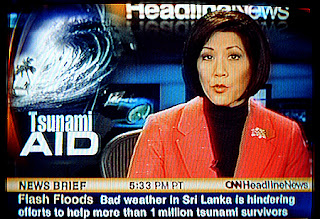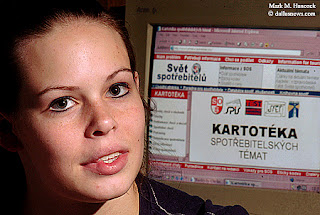
A television shows Sachi Koto presenting CNN Headline News on Sunday, January 1, 2005. The image shows the screen as it would be seen -- without scan lines or lapses.
As the world becomes more digital, PJs find it necessary to include televisions (TV) and computer monitors in images. People make their livings working with computers (for biz assignments) and become glued to televisions during major newsworthy events such as the attacks in New York.
Furthermore, if the assignment is a portrait of a TV producer or someone who created a Web site to raise funds for hurricane or tsunami relief agencies, the image requires a monitor in the frame.
PJs must be able to capture the scene as it appears to the casual observer. Because our modern landscape includes these light-emitting devices, we need to know how to make them look "normal."
How the monitor works
As I hinted in Balance the light, these devices are regulated by AC cycle speeds and must be corrected -- not only for color balance, but for speed.
Alternating current (AC), common household electrical current, reverses direction at 60 cycles per second in the United States (it's different in other countries). Televisions and computers use this same cycle speed to scan the phosphors inside monitor tube. Since humans see at about the same speed (1/60th) it's not distracting to watch a television or work on the computer.
However, camera shutter speeds record lapses in monitor scans. These lapses normally appear as dark lines on the monitor. Meanwhile, the areas struck by the scanning light is brighter because less time has passed since the phosphorus was illuminated.
The phosphoric material on the glass tube continues to glow after the light scans over it. It gets a refresher scan at 60 times per second. Consequently, the meter could be off by at least a stop depending on the scan cycle when the meter reading was taken and the speed of the meter itself.
As a side note, dogs see at about 1/125th. To them, the TV is nothing but annoying colored lines unless they have slower cognitive responses.
Monitor exposures
Each monitor and TV is different due to how it’s made and the brightness/contrast/color balance preferences of the device's primary user. This is further exasperated once we understand the screen itself is a light average.
With digital cameras, get an averaged reflective reading from (only) the screen as a starting point. Then, adjust until it looks right on the preview screen. Again, it varies from frame to frame, but it should be fine as long as it's within a stop.
With film cameras, it's always more difficult. An averaged exposure of (only) the monitor is a good starting point. A little logic would require exposure adjustments in accordance with the dynamic range. Add a stop if the screen is mostly white. Subtract a stop if the screen is mostly black. Then bracket exposures to create some flexibility if the settings were wrong.
Correcting for lapses
First, understand tripods and cable releases are required for any decent exposure. Because the scan cycle is 1/60th, this means the camera should be set for 1/50th or slower. Additionally, because the screen is a direct light source, any camera movement is recorded, so cable releases (digital, plunger or timer) are needed for a stable image.
Unlike other light measurements, less exposure is needed at higher speeds and more exposure is needed as shutter speed decreases because of the scanning average and the cumulative affect of light. Consequently, normal EV calculations won't work. Instead, take a new reading of only the monitor for each new f-stop because the accumulation of light changes. This still won't work with some meters, so walk it in third-stops to the right exposure with a dit or bracket a full stop with film cameras.
As an additional caution, the slower the shutter speed, the less variation there will be across the screen plane. This is fine for still images and documents on the screen, but adds difficulty to photographing moving images on the screen. For moving images, the photographer of the screen needs to time shots to slower moments as if s/he was shooting the actual event at the reduced shutter speed.
It's fun as brain candy, but not joyful on deadline.
Balancing light for the monitor
If above wasn't difficult enough, now we need to balance available light to the screen settings and color. The B&W shooters are laughing now.
We'll do the B&W version first. If the room is bright, the stars might align perfectly and the room exposure might match the screen exposure. Otherwise, it's artificial light (flash) time. Oh, you're outside at a tailgate party, then break out the neutral density filter (I'll save ND filters for another day).
If you need to use artificial light to balance exposure, the speed doesn't matter because the synch speed is within range. It's now a matter of output. If the cameras and dedicated flashes are high tech, switch to manual camera settings while in TTL (through the lens) flash mode. It might work.
To make sure it does work, use a manual flash meter. If the metering is off (because there's a darn light source in the frame), adjust the flash output in TTL or switch to full manual and set it accordingly (I'll save this for another day as well).
Because the monitor is made of glass and glass is reflective, make sure the light doesn't reflect off the monitor from the camera angle. This probably takes more tinkering with light angles, flash output, mathematics and several curses.

Mark M. Hancock / © The Dallas Morning News
Hayley Cheney, 15, poses for a portrait at her home in Mesquite on Friday, July 23, 2004. She is preparing to be a foreign exchange student for 11 months in the Czech Republic. She has taught herself the Czech language and has her computer set on Czech to help her learn faster.
Color balance
Although it's not part of the Kelvin color temperature chart for the same reason fluorescent lights aren't, guesstimate most screens average at about 9000K (open shade) depending again on its primary user's preferences.
If the screen is the primary subject, no problem. Turn out the room lights, set the dit for shade, expose, check the frame and split. Do the same for negative film and adjust in Photoshop. Use warming filter 81A in addition to above for positive films (chrome, slide).
If other subjects are part of the frame (a portrait), let the nightmares begin. ;-)
For practical purposes, balance available light for the shoot and balance the screen separately in Photoshop later (more on this soon).
Otherwise, masochists and PJs on tight deadlines need to get it right in one frame. Minimize available light (turn off the switch for a portrait) and use a light blue gel for the flash/strobe. Set dits for shade or use an 81A filter.
For those who want to prove a point, gel all available light sources and flash/strobe to 9000K and then counter with an 81A filter. It may need some additional Photoshop adjustments, but you must have lots of time to waste, so go for it.
Enough for now,


No comments:
Post a Comment